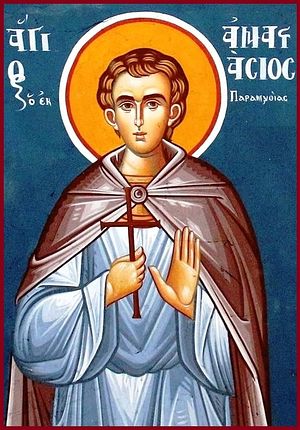Saint Anastasius and his sister were mid-18th century peasants living in Epirus during Ottoman times. When a band of Turks entered their village, its leader, Musa, was struck by the beauty of Anastasius' sister and tried to seize her, but Anastasius fought off the Turks, enabling his sister to escape. As a result, Anastasius was arrested, imprisoned, and tortured in an effort to get him to deny the Christian faith.
Moved by the manner in which Anastasius bore his sufferings, Musa wanted to know more about the faith that sustained him. Going secretly to Anastasius' cell, Musa saw two young men of shining appearance with Anastasius, but they vanished when Musa entered. Anastasius told him that these were angels who guard every Christian, especially when they suffer for Christ. He also explained the Gospel of Jesus Christ and how it had inspired him and others to place little value on worldly things. In response, Musa expressed his desire to embrace Christianity. Anastasius told him to wait until the proper time, because his conversion would bring about a persecution of the region's Christians. A few days later, in 1750, Anastasius was beheaded by order of Musa's father, the Pasha.
Subsequently, Musa was granted a vision of Anastasius encircled in light, who urged him to continue on the road to Christ. Musa fled his father's domain to the Peleponnese where he was instructed in the faith by an aged ascetic. After he was baptized, he became a monk on Corfu, receiving the monastic name of Daniel, and founded a church dedicated in honor of Saint Anastasius.

